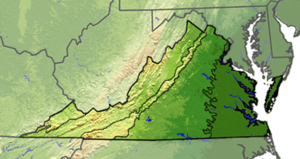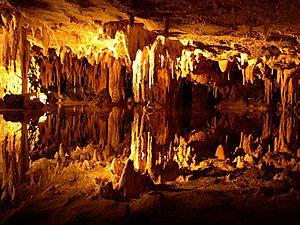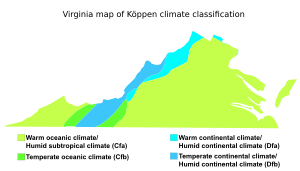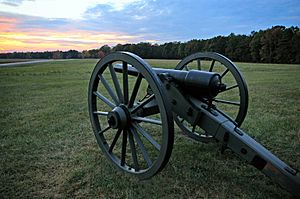Environment of Virginia facts for kids

The natural environment of Virginia is super interesting! It includes all the land, water, and living things in this U.S. state. Virginia covers about 42,774 square miles (110,785 square kilometers). This makes it the 35th largest state in the United States.
A big part of Virginia is covered by forests, about 65% of the state. Wetlands and water areas make up another 6% of the land. The rest, about 5%, is used for businesses, homes, and other developments.
Virginia shares its borders with many other places. To the north and east, it borders Maryland and Washington, D.C.. The Atlantic Ocean is to the east. To the south, you'll find North Carolina and Tennessee. Finally, to the west, Virginia borders Kentucky and West Virginia.
Two main state groups help protect Virginia's nature. These are the Department of Conservation and Recreation (DCR) and the Department of Environmental Quality (DEQ). They work hard to keep Virginia's environment healthy.
Contents
Virginia's Geographic Regions and Geology
Virginia has five main geographic regions. Each region has its own special landforms and rocks. Let's explore them from east to west:
- The Tidewater region is a flat coastal plain right by the Atlantic Ocean. It stretches from the coast to an area called the Fall Line. This region includes the Eastern Shore and large estuaries (where rivers meet the sea) that flow into the Chesapeake Bay.
- The Chesapeake Bay is a huge body of water that separates Virginia's mainland from its Eastern Shore. This bay was actually formed by a meteoroid impact a very long time ago! Many of Virginia's important rivers, like the Potomac, Rappahannock, James, and York, flow into the Chesapeake Bay. These rivers create three long land areas, called peninsulas, that stick out into the bay.
- The Piedmont region is made up of rolling hills, called foothills, located east of the mountains. These hills are formed from sedimentary rock and igneous rock. This area is known for its heavy clay soil.
- The Blue Ridge Mountains are part of the larger Appalachian Mountains chain. These mountains have the highest points in Virginia. The tallest peak is Mount Rogers, which stands at 5,729 feet (1,746 meters) tall.
- The Ridge and Valley region is west of the Blue Ridge Mountains. It includes the wide Great Appalachian Valley, which is home to the famous Shenandoah Valley. This region has a lot of carbonate rock, mostly limestone. Because of this, there are more than 4,000 karst formations (like caves) in Virginia! Ten of these caves are open for visitors to explore. Another amazing natural feature here, formed by limestone erosion, is the Natural Bridge.
- The Cumberland Plateau (also called the Appalachian Plateau) and the Cumberland Mountains are found in the very southwest corner of Virginia. In this region, rivers flow northwest into the Ohio River basin.
Virginia has some valuable natural resources. Coal mining happens in the three mountainous regions. Other resources like slate, sand, and gravel are also mined. These resources were worth over $2 billion in 2006!
Virginia doesn't have many big Earthquakes. It's located in the middle of the North American Plate, far from where Earth's plates meet. The largest earthquake recorded in Virginia was in 1897, near Blacksburg, with an estimated strength of 5.9. More recently, in August 2011, a 5.8 magnitude quake happened near Mineral, Virginia, and many people felt it across the state.
Virginia's Climate
Virginia's climate changes depending on where you are in the state. It gets warmer and more humid as you go farther south and east. Most of Virginia has a humid subtropical climate. This means it has hot, humid summers and mild winters. This climate stretches from the Blue Ridge Mountains all the way to the Atlantic coast. In the higher parts of the Blue Ridge Mountains, the climate is a bit cooler, like a subtropical highland climate.
Virginia's Amazing Ecology
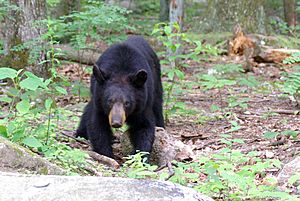
Virginia is home to many different types of natural environments, called ecoregions. These include coastal forests, mixed forests in the Piedmont, and different kinds of forests in the Appalachian Mountains.
The most common type of forest in Virginia is the oak-hickory forest. You'll find trees like white oak, red oak, black oak, and different kinds of hickory trees. Other common trees include tulip poplar, maple, beech, and dogwood.
Another big forest type is the oak-pine forest. Besides oaks, you'll see loblolly pine, shortleaf pine, and Virginia pine. These forests are mostly found near the coast and in the Piedmont region. In lower, wetter areas, you might find trees like willow oak, water oak, sweetgum, and red maple.
Virginia also has many other plants. You can find mountain laurel, milkweed, daisies, and many types of ferns. The largest areas of untouched nature are along the Atlantic coast and in the western mountains. These areas are home to many trillium wildflowers.
Animals of Virginia
Virginia is full of diverse wildlife! Here are some of the cool mammals you might spot:
- white-tailed deer
- black bear
- beaver
- bobcat
- coyote
- raccoon
- groundhog
- Virginia opossum
- gray fox
- red fox
- river otter
- Different types of squirrels and rabbits.
The state is also a birdwatcher's paradise! Some common birds include:
- Cardinals
- barred owls
- Carolina chickadees
- American robin
- blue jay
- great blue heron
- bald-eagle
- osprey
- red-tailed hawk
- wild turkeys
The peregrine falcon was even brought back to Shenandoah National Park in the 1990s!
Virginia's freshwaters are home to about 210 known types of fish, including walleye, brook trout, and blue catfish. Rocky streams often have lots of crayfish and salamanders.
The Chesapeake Bay is the largest and most diverse estuary in the United States. It's a busy home for many sea creatures! You can find:
- blue crab
- Clams
- Oysters
- Scallops
- Many kinds of fish like bay anchovies, American shad, Atlantic croaker, and rockfish (also called striped bass).
Virginia's Protected Lands
Virginia has many special places that are protected for everyone to enjoy. There are 30 areas managed by the National Park Service. These include places like Great Falls Park and parts of the famous Appalachian Trail. Virginia also has one national park, the Shenandoah National Park, which was created in 1935. Almost 40% of Shenandoah National Park is a designated wilderness area, meaning it's kept as wild as possible.
Scenic roads like the George Washington Memorial Parkway and the Blue Ridge Parkway (which includes the beautiful Skyline Drive) are also very popular national park sites.
Besides national parks, Virginia has 34 state parks and 17 state forests. These are managed by the Department of Conservation and Recreation and the Department of Forestry.
The Chesapeake Bay is also specially protected by both state and federal laws. There's a program called the Chesapeake Bay Program that works to restore the bay and its surrounding areas. The Great Dismal Swamp National Wildlife Refuge is another important protected area that stretches into North Carolina.
Virginia also has many open-air museums and historic battlefields. These include Colonial Williamsburg, Richmond National Battlefield, and Fredericksburg and Spotsylvania National Military Park. These sites help us learn about history while enjoying the outdoors.
Sometimes, there are places that need a lot of cleaning up because of pollution. These are called Superfund sites. As of 2010, Virginia had 31 such sites that were being cleaned. Four of these sites have already been successfully cleaned up and removed from the list!


